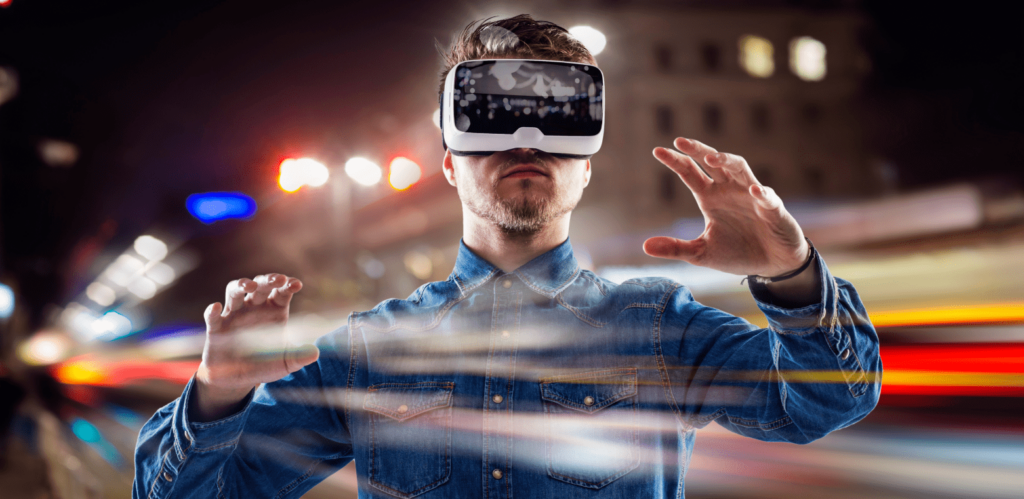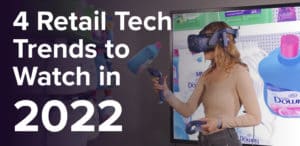Is your brand ready for the metaverse?

As we enter another digital transformation, it is critical for you to understand the players, bets and how to get into the metaverse.
What is the metaverse?
Metaverse is a term describing the technological shift that establishes a digital world existing beyond the one we are currently living. It incorporates technology such as AR and VR, but could also be accessed using computers, game consoles, and cellphones.
The metaverse is commonly visualized as an immersive, virtual reality environment. Users seamlessly travel across these digital experiences through use of wearable technology. This digital world creates a new digital economy where users can make, buy, and sell virtual goods. Companies and individuals that are influencing the development of the metaverse see it as the next evolution of the internet.
Who is creating and investing into the metaverse?
- Facebook (Meta) is spending at least $10 billion on its metaverse division this year.
- Meta and Microsoft have partnered to integrate workplace and teams. The two companies were originally thought to be battling for dominance in the space. They now understand that the metaverse will only work if there is cooperative participation across investments, integrations, and user adoption.
- Microsoft purchased Activision for $69 billion as a way to stake their claims to a virtual future. This is the biggest gaming industry deal in history.
- NVIDIA, the 7th largest company in America, are using NVIDIA Omniverse to position themselves as “a platform for connecting 3D worlds into a shared virtual universe”.
- Dropbox is also building towards a metaverse with their data repository services. The company intends to make it easy to get your digital content such as documents or presentations into the virtual space.
- Communication companies with 5G are another industry playing a part. Steve McLean, CEO of ReadySet VR, a virtual reality retail software company providing in-store planning, research and presentation solutions provided insight into this new technology.
- Entities that make their money on crafting and delivering experiences are carving out their patent play within the metaverse. An example of this can be seen through Disney’s metaverse technology patent for theme parks. This new application will track visitors while projecting personalized 3D images and virtual effects in physical spaces.
- Grocery stores are also enabling themselves to succeed in the metaverse through acceleration of online delivery services. Kroger has stepped up its unmanned grocery delivery in Houston. Investment into this technology will make it easy to institute fulfillment of purchases made through v-commerce (virtual reality shopping). Walmart has even filed several trademarks with intent to sell virtual goods, cryptocurrency, and NFTs.

“We have been talking for years about how the metaverse can only be functionally actualized and fully adopted when untethered from a cumbersome hardware infrastructure. In order to get people to participate at scale, wearables need to be lightweight, portable and seamless. This allows the experience to be purposeful and desirable within the context of their daily lives.
The rollout of 5G bandwidth will allow metaverse interactive content to be rendered remotely in real time and streamed to wearables. This establishes an infrastructure that will not only support frictionless VR hardware but also removes complications for multi-participant experiences.
You will be able to quickly turn your metaverse experience on and off at will, without being tethered to localized hardware or applications. This investment in 5G by communication companies will not be recouped solely by monthly cell phone contracts. These companies are positioning themselves as metaverse enablers.” - Steve McLean, CEO of ReadySet VR

Is the metaverse worth investing into? What is it worth?
Although there is a lot of current investment, it has left some companies wondering what this means for them. How can a potential investor profit from the knowledge of a metaverse?
According to an article in Forbes, the metaverse is a $1 trillion revenue opportunity. Another article by The Information estimated that video gaming, business communication and advertising in the metaverse could be worth at least $82 billion by 2025.
Ultimately, market size predictions reveal the metaverse has the potential to pull in some really big numbers. This led to a statement by the FTC that they will not make the same mistake of allowing large tech companies to act illegally and shut out the next generation of competitors.
Is the metaverse hype or “reality”?
There has been a lot of skepticism of new technology in the past. Many people say that we have seen these types of things in the past. They question if the metaverse is hype or a future “reality”.
The facts are that virtual reality is already a revolutionary technology that is influencing many areas in business. It is used for training healthcare workers on dangerous surgical procedures to planning and testing retail innovations before physical investment.
Given current utilization, size of the investments being made, and who is involved, the idea of dismissing a metaverse may leave your company playing catch-up. It would be damaging to become one of the organizations that falls behind due to uncertainty. As many did with the introduction of computers and the first iteration of the internet.

What are the barriers to consumer adoption?
The current trend of people adopting VR is very compelling. According to estimates from Fortune Business Insights, global VR market growth is to increase from $6.3 billion in 2021 to $84.09 billion in 2028. Although VR use is increasing by large numbers, there are still a few areas of improvement before mass adoption.
The largest barrier to metaverse adoption is the expensive and bulky VR hardware that is required for participation. These barriers are beginning to be broken down through the introduction of new, lightweight VR headsets and controllers.
This type of change can be seen through the Vive hardware evolution. Traditional VR hardware like the Vive Pro Eye 2 Kit consists of a headset weighing 850g with controllers and base stations priced at $1,399.00. The company recently released the Vive Flow immersive VR glasses in late November for $499. These glasses are branded as “Your VR Companion in the Metaverse” as they are sleek and weigh only 89g.
What role do NFTs play in the metaverse?
At its core, non-fungible tokens (NFTs) are a way to identify a blockchain enabled asset. They are a means of transaction and validating ownership of these assets. NFTs are also hypercritical to enable digital ownership within the metaverse.
As far as the relevance of NFTs, we have witnessed the NFT kingpin OpenSea land a valuation of $13.3 billion. This was incredible growth from the $1.5 billion it was given just six months before. It turned out to be one of the largest growths seen by any startup at the time. There are also new ventures such as the first NFT art museum opened in Seattle on January 14th of this year.

Can you buy real estate in the metaverse? How?
There is a prevailing school of thought that metaverse property proximity matters similarly to the real world. This has led to an increase in purchase of properties in virtual real estate such as concert venues and shopping malls.
These transactions are carried out using cryptocurrency because finance in the metaverse is powered by blockchain. By using cryptocurrency as money, there is no need for a bank or third party. A recent purchase of a patch of digital land in “Decentraland”, a popular metaverse virtual reality environment, sold for $2.43 million worth of cryptocurrency.

Are there current players in the metaverse?
Some virtual worlds with economies are already here and include popular environments such as “The Sandbox”, “Decentraland”, and “Minecraft”. One platform that has a highly successful metaverse world is Roblox. Roblox has 47 million daily active global users and over 24 million user-created experiences for players to dive into.

How are consumers and brands preparing for the metaverse?
We are already seeing brands and customer behavior that is literally preparing for the metaverse by purchase of digital assets. This can be seen with digital fashion purchases, which consumers are using as a way to easily, cost-effectively, and ethically show their style online.
Brands such as Nike are filing trademarks to make and sell virtual sneakers and apparel. The fashion brand Ralph Lauren is also using digital apparel to attract younger shoppers and dip their toes into the metaverse.
Other companies are even taking metaverse initiatives a step further, by beginning investment into digital stores or restaurants. McDonald's recently filed a series of trademarks for a virtual restaurant that will deliver food online and in person.
This trend towards a more digital focused strategy has been in the works for a while. In fact, virtual stores have been utilized for many years in order to provide economical planning solutions and innovative customer experiences. Today, these short-term uses for virtual shopping environments are being viewed as a long-term strategy for entering the metaverse.

How to join the metaverse
The easiest way to enter the metaverse will be by integrating augmented reality and VR technology into your company profile right now. Through advancement of digital initiatives and partnerships with virtual reality software providers, companies will be able to assemble worthwhile virtual assets for the future. Brands that adopt VR stores and products now will discover a faster path to building authority within the metaverse.
Subscribe to our newsletter
Get our blogs and the latest retail news delivered to your inbox monthly.
Recent Posts
Virtual Cannabis Stores Deliver Better Retail Experiences
Virtual reality is being used to educate customers on cannabis products and establish a dispensary brand image. The cannabis industry is growing rapidly with the expectation that it will continue to do so as more states legalize. Research shows that the legal cannabis market will grow 20-30% per year to the price of 50 billion…
4 Retail Tech Trends to Watch in 2022
Modern retail checkout counters and virtual retail labs are 2022 technology trends shaping the retail industry over the next year. The continued turbulence of 2021 has left the retail industry with new consumer behaviors, labor shortages, supply chain issues and accelerated online solutions. As tech in retail becomes necessary to provide superior customer experiences, more…
How Retail is Using VR to Innovate Planograms Amid Product Shortage
The labor and product shortages in 2021 has made it difficult for stores to keep shelves stocked. Virtual reality is providing a collaborative space for innovation despite global supply chain realities. Pandemic induced supply chain issues and labor shortages in 2021 have changed retail experiences and strategies. Just as retailers were ramping up their assortments…



